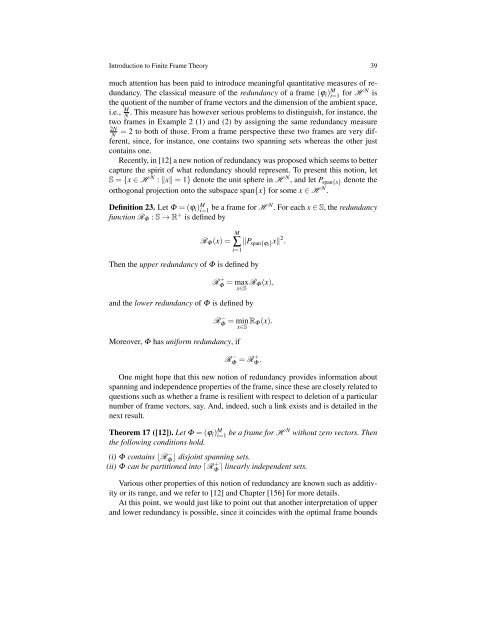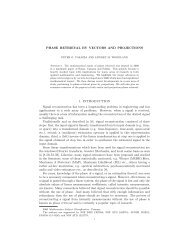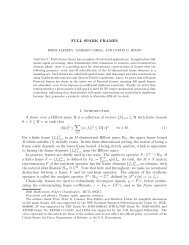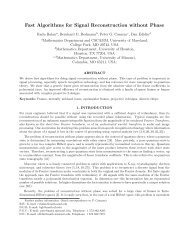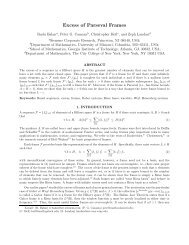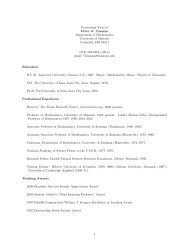Introduction to Finite Frame Theory - Frame Research Center
Introduction to Finite Frame Theory - Frame Research Center
Introduction to Finite Frame Theory - Frame Research Center
You also want an ePaper? Increase the reach of your titles
YUMPU automatically turns print PDFs into web optimized ePapers that Google loves.
<strong>Introduction</strong> <strong>to</strong> <strong>Finite</strong> <strong>Frame</strong> <strong>Theory</strong> 39<br />
much attention has been paid <strong>to</strong> introduce meaningful quantitative measures of redundancy.<br />
The classical measure of the redundancy of a frame (ϕ i ) M i=1 for H N is<br />
the quotient of the number of frame vec<strong>to</strong>rs and the dimension of the ambient space,<br />
i.e., M N<br />
. This measure has however serious problems <strong>to</strong> distinguish, for instance, the<br />
two frames in Example 2 (1) and (2) by assigning the same redundancy measure<br />
2N<br />
N<br />
= 2 <strong>to</strong> both of those. From a frame perspective these two frames are very different,<br />
since, for instance, one contains two spanning sets whereas the other just<br />
contains one.<br />
Recently, in [12] a new notion of redundancy was proposed which seems <strong>to</strong> better<br />
capture the spirit of what redundancy should represent. To present this notion, let<br />
S = {x ∈ H N : ‖x‖ = 1} denote the unit sphere in H N , and let P span{x} denote the<br />
orthogonal projection on<strong>to</strong> the subspace span{x} for some x ∈ H N .<br />
Definition 23. Let Φ = (ϕ i ) M i=1 be a frame for H N . For each x ∈ S, the redundancy<br />
function R Φ : S → R + is defined by<br />
R Φ (x) =<br />
M<br />
∑<br />
i=1<br />
Then the upper redundancy of Φ is defined by<br />
‖P span{ϕi }x‖ 2 .<br />
R + Φ = max<br />
x∈S R Φ(x),<br />
and the lower redundancy of Φ is defined by<br />
Moreover, Φ has uniform redundancy, if<br />
R − Φ = min<br />
x∈S R Φ(x).<br />
R − Φ = R+ Φ .<br />
One might hope that this new notion of redundancy provides information about<br />
spanning and independence properties of the frame, since these are closely related <strong>to</strong><br />
questions such as whether a frame is resilient with respect <strong>to</strong> deletion of a particular<br />
number of frame vec<strong>to</strong>rs, say. And, indeed, such a link exists and is detailed in the<br />
next result.<br />
Theorem 17 ([12]). Let Φ = (ϕ i ) M i=1 be a frame for H N without zero vec<strong>to</strong>rs. Then<br />
the following conditions hold.<br />
(i) Φ contains ⌊RΦ − ⌋ disjoint spanning sets.<br />
(ii) Φ can be partitioned in<strong>to</strong> ⌈R<br />
Φ + ⌉ linearly independent sets.<br />
Various other properties of this notion of redundancy are known such as additivity<br />
or its range, and we refer <strong>to</strong> [12] and Chapter [156] for more details.<br />
At this point, we would just like <strong>to</strong> point out that another interpretation of upper<br />
and lower redundancy is possible, since it coincides with the optimal frame bounds


